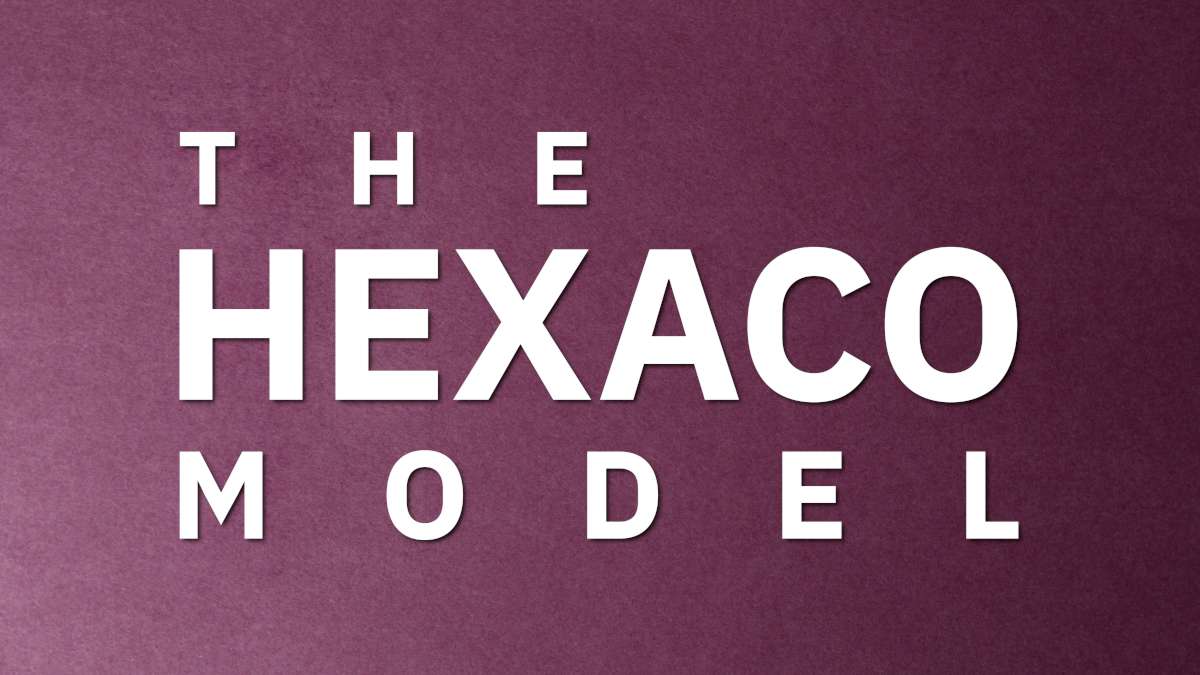The HEXACO model, created by Michael C. Ashton and Kibeom Lee, is a human personality traits theory, based on psycholexical hypotheses. To formulate their theory, Ashton and Lee drew upon the work of Goldberg, and Costa/McCrae; who developed the acclaimed Big Five model and its facets, accordingly.
In particular, the HEXACO model maintains that human personality can be broadly ‘distilled’ into 6 different dimensions or continuums; namely, Honesty-Humility (H), Emotionality (E), eXtraversion (X), Agreeableness (A), Conscientiousness (C), and Openness (O) — hence the theory’s name.
Just like the Big Five model, HEXACO is an important theory, not only in psychometrics, but also in I/O psychology (i.e. Industrial-Organizational psychology); the latter is a scientific branch that studies human personality and behavior in the workplace. By extension, it is also a valuable assessment tool in HR departments for recruiting, team building, and training projects.
Adding to the Big Five: A brief history of the HEXACO model
Back in the 90s, the Big Five model — also known as the OCEAN model — was established, in the field of psychometrics, as a valid means for personality assessment. This theory was based on lexical hypothesis research on the English language, outlining five broad dimensions of human personality; specifically, Openness, Conscientiousness, Extraversion, Agreeableness, and Neuroticism.
A decade later, in the early ‘00s, with the rise of technology and cross-cultural relations, researchers started focusing on psycholexical studies, across multiple languages. Having studied the Big Five model, researchers Michael C. Ashton and Kibeom Lee have managed to develop an alternative approach.
They named this new personality traits theory the HEXACO model, where they replaced a Big Five factor with a new one, and added yet another fundamental, factor-analyzed personality trait. To further explain, they added the Honesty-Humility trait and replaced Neuroticism with Emotionality — a somewhat correlating (to the former) trait. At the same time, they retained the rest of the factors of the Big Five spectrum; nevertheless, Agreeableness is analyzed differently in the HEXACO model.
Personality traits and facets of the HEXACO model
As mentioned, the HEXACO model studies 6 main dimensions/characteristics in the human personality and, to reiterate, they comprise Honesty-Humility, Emotionality, Extraversion, Agreeableness, Conscientiousness, and Openness (to experience). We refer to these characteristics as the Domain-Level Scales, and they consist of broad descriptions of the main personality traits.
In addition, each of these domain-level scales is associated with four correlating Facet-Level Scales. Simply put, those facets are more specific aspects of the main factors, offering a deeper insight into the personality. According to the Ashton-Lee research, we can enumerate the Domain-Level Scales and their Facet-Level Scales as follows:
- Honesty-Humility domain: Sincerity, Fairness, Greed Avoidance, Modesty
- Emotionality domain: Fearfulness, Anxiety, Dependence, Sentimentality
- eXtraversion domain: Social Self-Esteem, Social Boldness, Sociability, Liveliness
- Agreeableness domain: Forgivingness, Gentleness, Flexibility, Patience
- Conscientiousness domain: Organization, Diligence, Perfectionism, Prudence
- Openness domain: Aesthetic Appreciation, Inquisitiveness, Creativity, Unconventionality
1. Honesty-Humility: The H-factor
In a sense, the H-factor in the HEXACO model evaluates a person’s moral compass, revealing their intentions toward others, as well as their behavior towards rules. All things considered, those who score high on the Honesty-Humility scale are a what-you-see-is-what-you-get (WYSIWYG) type of people. In other words, they are likely to be truthful, loyal, modest, and humble, do everything by the book, and show very little interest (if any) in high social status, wealth, and lavishness.
Conversely, people with a low score are more likely to be manipulative, deceitful, pretentious, boastful, and self-important; furthermore, they don’t hesitate to break the rules, nor flatter others, for their personal gain.
Honesty-Humility Facet-Level Scales insights
- The Sincerity scale measures truthfulness and how genuine someone is with others
- The Fairness scale gauges impartiality and righteousness
- The Greed Avoidance scale assesses the views one has of high social status, wealth, and lavishness
- The Modesty scale evaluates one’s humility, as opposed to considering oneself superior to other people; thus, entitled to special attention or treatment.
2. Emotionality
People who score high in Emotionality are sentimental and, generally speaking, oversensitive. Typically, they are prone to experience anxiety, agitation, hostility, fearfulness, vulnerability, depression — and in extreme cases, even paranoia. Despite their emotional instability, they display a higher level of empathy and compassion towards others, and they easily form sentimental attachments.
On the other hand, people who score low tend to feel emotionally detached from life’s stresses; and are usually unaffected by others’ emotional reactions. More often than not, they seem stolid and rather cold. However, they are more likely to be brave, independent, self-assured, and experience emotional stability.
Emotionality Facet-Level Scales insights
- The Fearfulness scale evaluates a person’s tendency to feel fear (flight or fight reflex)
- The Anxiety scale assesses the feelings of worry and stress in difficult situations
- The Dependence scale measures one’s emotional reliance on others
- The Sentimentality scale rates empathy, and to what extent one feels emotionally attached to others.
3. eXtraversion
Those with a high score on the eXtraversion scale of the HEXACO model are, by and large, outgoing, sociable, enthusiastic, confident, talkative, buoyant, and lively. Ordinarily, they feel refreshed from interacting with others. In fact, they are at their best when they are with other people.
That is, in contrast to those who score low on this scale, and who feel uncomfortable around others; even drained after interacting with many people. In general, they are shy, reserved, and taciturn. If they find themselves at the center of attention, they feel embarrassed, nervous, and are likely to behave awkwardly.
eXtraversion Facet-Level Scales insights
- The Social Self-Esteem scale assesses self-regard in social circumstances
- The Social Boldness scale evaluates a person’s courage in social contexts e.g. how comfortable one feels to speak in public
- The Sociability scale measures one’s capacity to interact with other people
- The Liveliness scale indicates the level of enthusiasm and energy
4. Agreeableness
The high scorers on the Agreeableness scale tend to be patient, tolerant, understanding, mild, and gentle. Driven by peace, they are forgiving and willing to compromise, in order to cooperate harmoniously with others.
Conversely, the low scorers are more likely to have a short fuse, they are reactive, competitive, stubborn, opinionated, and judgemental; they also ‘hold grudges’ when wronged or mistreated.
Agreeableness Facet-Level Scales insights
- The Forgivingness scale measures the capacity to forgive
- The Gentleness scale gauges mildness and leniency
- The Flexibility scale assesses the ability to compromise and cooperate
- The Patience scale measures tolerance, forbearance, and acceptance of other peoples’ shortcomings
5. Conscientiousness
Commonly, people with high rates on the Conscientiousness scale tend to be organized, disciplined, tidy, diligent, thorough, and careful. They are true perfectionists, so everything needs to meet the highest of standards. Consequently, they’re always laser-focused on details and strive for precision.
On the other side of the spectrum, those who rank low tend to be impulsive, disorganized, sloppy, haphazard, lazy, absent-minded, and usually make decisions on the spur of the moment. Unlike high scorers, they don’t concern themselves with schedules and details, and certainly don’t go after perfection; quite conversely, they may overlook minor flaws or errors.
Conscientiousness Facet-Level Scales insights
- The Organization scale measures the capacity for order and structure
- The Diligence scale evaluates self-exertion and self-discipline
- The Perfectionism scale assesses attention to detail and one’s willingness to strive for the best result possible
- The Prudence scale gauges self-control, cautiousness, and sound judgment
6. Openness (to experience)
Openness high scorers are best described as artists of sorts, intellectuals, and innovators. They are visionaries who are attracted to unconventional ideas, as well as people. Driven by their longing to discover new, exciting things and places, these curious folks like to experiment and roam the planet to explore unmapped places.
On the other side of the coin, people who rank low on this scale, don’t care much for art, and they certainly feel little intellectual curiosity. Conventional individuals as they are, ideas that seem unusual don’t appeal to them. In fact, they might feel intimidated by such notions. Normally, they don’t break out of their comfort zone, and routine is their shelter; in this respect, they may seem skin-deep and indifferent.
Openness Facet-Level Scales insights
- The Aesthetic Appreciation scale evaluates how one perceives beauty in nature and art
- The Inquisitiveness scale measures intellectual curiosity
- The Creativity scale assesses one’s imagination, as well as inclination to experimentation, and innovation
- The Unconventionality scale gauges a tendency to accept the eccentric, and the unusual
The HEXACO model in recruitment
When it comes to hiring people, personality is as important as skills — if not more important. A person’s character can convey a lot to an HR professional about their work ethic, and how they interact with others. To that end, the HEXACO model is a valuable assessment tool, for a recruiter to conclude whether a candidate is a good fit for a company or not.
Practically speaking, there are several inventory versions for the HEXACO model. However, to conduct a reliable evaluation of a candidate’s character, one requires a minimum of 60 questions. Many times, recruiters use the 100-question version, because it offers a more thorough evaluation.
The H-factor in the workplace
There are several applications of the H-factor in the workplace, and recruiters know that when they size up one’s character using the HEXACO model. As most businesses operate on a social layout, a high H-factor score points out to people who tend to operate well within teams.
And how do we know this? At any rate, these people are unpretentious and like to keep things simple; that is to say that they are original, honest, and uncomplicated, and this may be very liberating for the people who cooperate with them. That especially applies if they score high on the Sincere and Modesty facets.
Likewise, these people are just and impartial, so other people feel fairly treated. Of course, that goes more for the Fairness high scorers. Moreover, moral and trustworthy as they are, they are less subject to corruption and fraud; this better fits those who score high on the Greed Avoidance facet.
Naturally, not all jobs require someone with a high rate on the H-factor, but there are many that having a high score on that trait is imperative to perform well; for example, a police/military officer post, a teacher position, or jobs that have to do with finances and assets in general.
TL;DR
Since its early development in the early ’00s, the HEXACO personality inventory has been used to probe into different aspects of the human personality; therefore, allowing for not only behavioral evaluation, but also prediction. Even more so in the field of psychometrics, which studies how certain personality traits best fit certain jobs.
The HEXACO model surely offers another view of the personality that may prove to be substantial for specific job positions. In that light, as a tool, it can make all the difference — for both people and companies — in the hands of psychologists and HR professionals.



